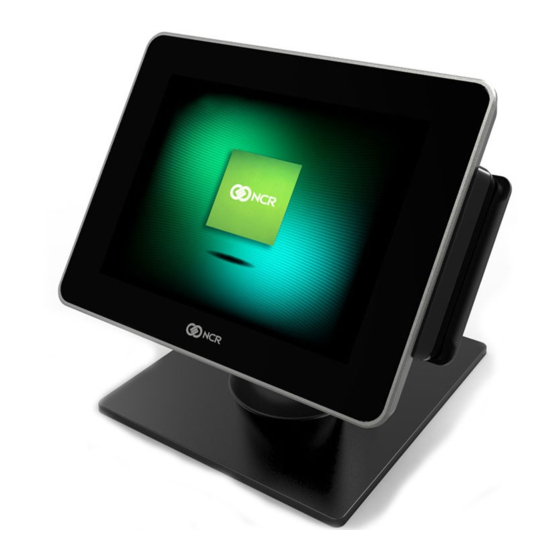
Table of Contents
Advertisement
Advertisement
Table of Contents

Summarization of Contents
Preface
Audience
Information about the intended readers of this user guide.
Safety Requirements
Essential safety precautions and warnings for operating the device.
Chapter 1: Product Overview
Introduction
Overview of the NCR RealPOS X-Series Displays and their features.
Product IDs
Details on model numbers, LCD size, and touch types for displays.
Standard Features
Lists and describes the standard capabilities and specifications of the display units.
Optional Features
Outlines the optional components and accessories available for the displays.
Compatibility
Lists host terminals compatible with the NCR X-Series Display.
Supported Resolutions
Details the display resolutions supported by different models.
Configurations
Visual representation of different display sizes and aspect ratios.
Display
Illustrates the 10.4", 15", and 18.5" display models available.
Biometrics and MSR
Explains the integrated Biometrics Reader and Magnetic Stripe Reader functionality.
Capacitive Biometric Reader
Details the Capacitive Biometric Reader for specific display models.
Imager
Describes the integrated Imager functionality for the display.
Keypad
Details the optional Keypad for the 15" display model.
Display Mounts
Introduces various mounting options available for the display units.
X-Series Table Top Stand
Describes the X-Series Table Top Stand and its part numbers.
XL Series Table Top Stand
Details the XL Series Table Top Stand and its part numbers.
XR Series Table Top Stand
Explains the XR Series Table Top Stand with Power Brick.
Integration Tray Mount
Information on the Integration Tray Mount for the display.
Checkstand Mount
Details the Checkstand Mount for the display.
Wall Mount
Describes the Wall Mount option for the display.
VESA Mount Spacer
Explains the use of the VESA Mount Spacer for mounting.
X-Series Display Extension Arm Mount
Details the Extension Arm Mount for secondary displays.
Pole Mount
Information on the Pole Mount for the 10.4" display.
Pole and Table Top Mount
Describes the 12" Pole and Table Top Mount options.
Power Indicator
Explains the functions and colors of the front panel power LED.
Label Locations
Identifies the locations of serial number, certification, and model labels.
Chapter 2: Hardware Installation
Installation Restrictions
Guidelines and restrictions before installing the display unit.
Ergonomic Workplace
Recommendations for optimal terminal placement for user comfort.
Installing the Display
Explains how to perform an out-of-box installation and connect cables.
Connecting the Host Terminal Cables
Steps for unpacking and pivoting the display for cable connection.
Connecting to a POS
Illustrates how to connect the display to a Point of Sale terminal.
Data and Power Connections
Details connections for data and power using USB.
Powered USB Cable
Explains the use of the Powered USB Cable for data and power.
External Power Cables
Describes connecting the display using an external power cable.
Video and Audio Connections
Outlines various video and audio connection options.
DisplayPort Cable
Explains connecting the display using a DisplayPort cable.
HDMI Cable
Details how to connect the display using an HDMI cable.
DVI to HDMI Cable
Describes using a DVI to HDMI cable for video connection.
VGA Cable
Explains connecting the display using a VGA cable.
Cable Routing
Instructions for routing cables to prevent strain.
Routing Cables for Strain Relief
Specific methods for routing cables using zip ties for strain relief.
Chapter 3: Operation and Cleaning
Touch Screens
Describes the two types of touch screens available for the display.
Projected Capacitive Touch Screen
Details the benefits and characteristics of PCap touch screens.
Resistive Touch Screen
Explains the construction and operation of resistive touch screens.
Magnetic Stripe Reader
Information on the Magnetic Stripe Reader (MSR) types and usage.
Care of Cards
Guidelines for handling cards used with the MSR.
Card Thickness
Specifies the acceptable thickness range for cards used in the MSR.
Biometrics Fingerprint Reader
Explains the importance and usage of the biometric fingerprint reader.
Sensor Cleaning Procedures
Daily cleaning procedures for the biometric sensor.
Software Drivers
Lists the modules and drivers for the RealPOS Biometrics Readers.
Cabinet Cleaning Procedures
Instructions for safely cleaning the display unit's cabinet.
Chapter 4: NCR Software OSD Utility
Introduction
Overview of the NCR Software OSD application for display adjustments.
Supported Features
Lists the display parameters adjustable via the OSD utility.
Installing the Utility
Step-by-step guide to download and install the OSD utility.
Running the Utility (GUI Version)
Instructions for running the graphical version of the OSD utility.
Main Menu
Overview of the main interface of the NCR Software OSD application.
Monitors Detected Panel
Describes the panel listing connected monitors.
Center Panel
Explains the panel displaying selected control information.
Control Buttons
Details the function of various control buttons in the OSD utility.
Brightness
Tools for adjusting display brightness settings.
Contrast
Tools for adjusting display contrast settings.
Positioning
Tools for moving the image on the display.
Size
Tools for adjusting the image height and width.
Phase
Tools for adjusting the sampling clock phase shift.
Clock
Tools for adjusting the video sampling clock frequency.
Colour
Tools for adjusting display color settings.
Sharpness
Tools for adjusting display sharpness settings.
Degauss
Tools for performing a degauss cycle, primarily for CRT displays.
Moire
Tools for canceling vertical or horizontal moiré picture effects.
Language
Lists supported languages and allows OSD language changes.
Display Adjustment Procedures
Explains the general procedure for adjusting display settings.
Restore
Functions for resetting display settings to factory defaults.
Resetting Factory Defaults
Detailed steps for resetting display settings to factory defaults.
Appendix A: Touch Screen Calibration
Proper Touch Screen Methods
Guidelines for correctly touching the screen during calibration.
Calibrating the Touch Screen
General procedure for calibrating touch screens.
Resistive Touch Screen Calibration
Specific steps to calibrate resistive touch screens.
PCap Touch Screen Calibration
Procedure for recalibrating PCap touch screens if needed.















Need help?
Do you have a question about the 5968 and is the answer not in the manual?
Questions and answers